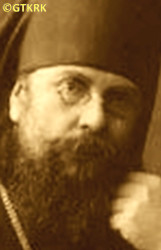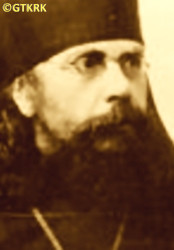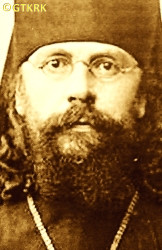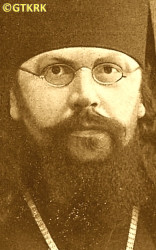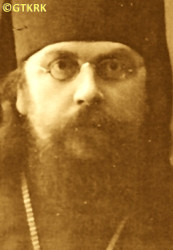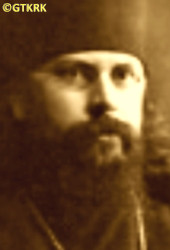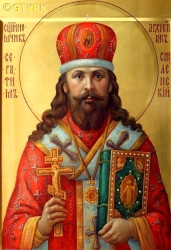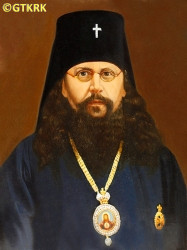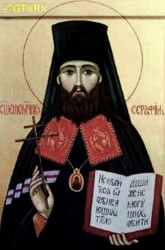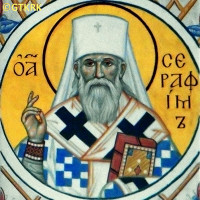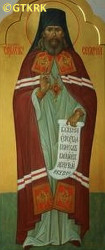Roman Catholic
St Sigismund parish
05-507 Słomczyn
85 Wiślana Str.
Konstancin deanery
Warsaw archdiocese, Poland
full list:
displayClick to display full list

searchClick to search full list by categories
wyświetlKliknij by wyświetlić pełną listę po polsku

szukajKliknij by przeszukać listę wg kategorii po polsku

Martyrology of the clergy — Poland
XX century (1914 – 1989)
personal data
religious status
saint
surname
OSTROUMOW
forename(s)
Michael (pl. Michał)
religious forename(s)
Seraphim (pl. Serafin)

canonisation date
17.07.2001

Council of Bishops of the Russian Orthodox Churchmore on
en.wikipedia.org
[access: 2020.09.24]
function
bishop
creed
Eastern Orthodox Church ORmore on
en.wikipedia.org
[access: 2014.09.21]
diocese / province
Smolensk‐Dorohobuzh OR eparchymore on
en.wikipedia.org
[access: 2020.09.24]
Oryol OR eparchymore on
drevo-info.ru
[access: 2020.09.24]
Chelm OR eparchymore on
pl.wikipedia.org
[access: 2020.09.24]
academic distinctions
Sacred Orthodox Theology Candidate
nationality
Russian
date and place
of death
08.12.1937

NKVD Katynholiday resort
form.: Kozye Gory forest
today: Smolensk reg., Smolensk oblast, Russia
more on
en.wikipedia.org
[access: 2020.09.24]
details of death
During World War I after Russian defeat by German and Austro–Hungarian troops at battle of Gorlice in 05.1915 escaped to Russia, together virtually all clergy, Chełm eparchy and went east (during a mass exodus).
Settled in Moscow.
On 14.03.1918 when ministered as bishop of Orel eparchy locked down by Russians–Bolsheviks in home arrest without correspondence rights.
Interrogated.
On 06.07.1918 Russians conducted search of his house.
In 1922 arrested accused of protesting against confiscations of Church property and valuables.
In 06.1922 sentence in Orel to 7 years of prison in strict isolation.
The sentence subsequently got reduced to 1.5 years.
Held in Orel prison.
Release in 1924, after a year and 10 months in jail.
Return to Orel but in 12.1926 arrested again and forced to leave his eparchy.
In 11.11.1936 arrested yet again, this time in Smolensk.
Accused on „organisation of anti–Russian agitation and leading the counter–revolutionary group”.
On 27.03.1937 tried with 8 other priests.
Sentenced to 5 years of prison and in 04.1937 sent to Russian slave labour concentration camp ITL KarLag (part of Gulag system) in Karaganda in Kazakhstan.
In 11.1937 his case was again renewed.
After a half a year in the camp broght back — with 31 other prisoners — to Smolensk.
There on 28.11.1937 accused of „anti–Russian activities” and sentenced to death by Russian genocidal kangaroo court known as «NKVD Troika».
Taken to and execution site and murdered.
cause of death
mass murder
perpetrators
Russians
sites and events
11.08.1937 Russian genocideClick to display the description, Great Purge 1937Click to display the description, NKWD KatynClick to display the description, ITL KarLagClick to display the description
date and place
of birth
06.11.1880

Moscowtoday: Moscow city, Russia
more on
en.wikipedia.org
[access: 2020.07.31]
parents
OSTROUMOW Mitrophan
🞲 ?, ? — 🕆 ?, ?

🞲 ?, ? — 🕆 ?, ?
religious vows
13.09.1904 (permanent)
presbyter (holy orders)
ordination
19.09.1904

positions held
01.11.1927 – 1937
bishop — Russian Orthodox Church ⋄ Smolensk‐Dorohobuzh OR eparchy
from 29.05.1924
archbishop — Russian Orthodox Church
18.08.1917 – 01.11.1927
bishop — Russian Orthodox Church ⋄ Oryol‐Sevsk OR eparchy — elected „by the flock”, also: honorary member of the Oryol Church Historical Society, author of photo albums of the Oryol region, in c. 1917 delegate to the All–Russian Congress of the Clergy and Laity
27.05.1917 – 18.08.1917
auxiliary bishop — Oryoltoday: Oryol oblast, Russia
more on
en.wikipedia.org
[access: 2021.09.17] ⋄ vicariate, Russian Orthodox Church ⋄ Oryol‐Sevsk OR eparchy — Lat. locum tenens (Eng. „holding reins”), acting („ad interim”)
03.04.1916 – 1917
auxiliary bishop — Biała Podlaskatoday: Biała Podlaska city pov., Lublin voiv., Poland
more on
en.wikipedia.org
[access: 2021.08.20] ⋄ vicariate, Russian Orthodox Church ⋄ Chełm OR eparchy — appointment: on 24.02.1916, Lat. locum tenens (Eng. „holding reins”), acting („ad interim”); most of the eparchy's clergy evacuated in 1915 deep into Russia (so‐called bezhenstvo)
from 1916
Bishop — Russian Orthodox Church — bishop's cheirotonia, i.e. ordination, 03.04.1916 in Moscow
28.01.1914 – 1915
rector — Chełmtoday: Chełm city pov., Lublin voiv., Poland
more on
en.wikipedia.org
[access: 2021.08.20] ⋄ Orthodox Theological Seminary — also: chairman of the Kholm Diocesan School Council, member of the Council of the Holy Mother of God Brotherhood, editor of the eparchy's newspapers „Kholm Church Life” and „National Newspaper”
02.02.1908
Archimandrite, i.e. superior abbot — Russian Orthodox Church ⋄ Chełm OR eparchy — dignity conferment; dean of eparchy's monasteries
1907 – 1914
hegumen–superior — Jabłecznatoday: Sławatycze gm., Biała Podlaska pov., Lublin voiv., Poland
more on
en.wikipedia.org
[access: 2021.12.18] ⋄ St Onuphrius OR monastery (stavropegial) — with a short break in 1909, when was appointed missionary of the Chełm parchy; also: principal of a monastery high school (with courses for future teachers)
1906 – 1907
hegumen–superior — Jabłecznatoday: Sławatycze gm., Biała Podlaska pov., Lublin voiv., Poland
more on
en.wikipedia.org
[access: 2021.12.18] ⋄ St Onuphrius OR monastery (stavropegial) — acting („ad interim”)
1904 – 1906
deputy professor — Moscowtoday: Moscow city, Russia
more on
en.wikipedia.org
[access: 2020.07.31] ⋄ Department of Theory and History of Orthodox Homiletics, Orthodox Theological Academy — without the right to give lectures
19.09.1904
hieromonk — Russian Orthodox Church ⋄ Chełm OR eparchy — priesthood cheirotonia, i.e. ordination, on 14.09.1904 preceded by deacon cheirotonia and on 13.09.1904 by monk’s vows
till 1904
student — Moscowtoday: Moscow city, Russia
more on
en.wikipedia.org
[access: 2020.07.31] ⋄ philosophy and theology, Orthodox Theological Academy — postgraduate specialised studies crowned with Sacred Orthodox Theology Candidate's degree
till 1900
student — Moscowtoday: Moscow city, Russia
more on
en.wikipedia.org
[access: 2020.07.31] ⋄ philosophy and theology, Orthodox Theological Seminary
others related
in death
KULHAWIECClick to display biography Simeon, STEPANIUKClick to display biography George, GUDKOClick to display biography Basil (Bp Ambrose), NIKATOWClick to display biography Alex, SAWICKIClick to display biography Yaroslav, SIENKIEWICZClick to display biography Alex, GAGALUKClick to display biography Anthony (Abp Onuphrius), STROCIUKClick to display biography Leontius, BLUMOWICZClick to display biography John, SZACHMUĆClick to display biography Roman (Fr Seraphim), PANASIEWICZClick to display biography Emilian, MIEDWIEDIUKClick to display biography Vladimir, SMOLENIECClick to display biography Alexander (Abp Arsenius), MARCENKOClick to display biography Alexander (Abp Anthony), BORZAKOWSKIClick to display biography Alexander (Abp Agapit), DIERNOWClick to display biography Anatol (Abp Abramius)
sites and events
descriptions
11.08.1937 Russian genocide: On 11.08.1937 Russian leader Stalin decided and NKVD head, Nicholas Jeżow, signed a «Polish operation» executive order no 00485. 139,835 Poles living in Russia were thus sentenced summarily to death. According to the records of the „Memorial” International Association for Historical, Educational, Charitable and Defense of Human Rights (Rus. Международное историко‐просветительское, правозащитное и благотворительное общество „Мемориал”), specialising with historical research and promoting knowledge about the victims of Russian repressions — 111,091 were murdered. 28,744 were sentenced to deportation to concentration camps in Gulag. Altogether however more than 100,000 Poles were deported, mainly to Kazakhstan, Siberia, Kharkov and Dniepropetrovsk. According to some historians, the number of victims should be multiplied by at least two, because not only the named persons were murdered, but entire Polish families (the mere suspicion of Polish nationality was sufficient). Taking into account the fact that the given number does not include the genocide in eastern Russia (Siberia), the number of victims may be as high as 500,000 Poles. (more on: en.wikipedia.orgClick to attempt to display webpage
[access: 2016.03.14])
Great Purge 1937: „Great Terror” (also «Great Purge», also called „Yezhovshchyna” after the name of the then head of the NKVD) — a Russian state action of political terror, planned and directed against millions of innocent victims — national minorities, wealthier peasants (kulaks), people considered opponents political, army officers, the greatest intensity of which took place from 09.1936 to 08.1938. It reached its peak starting in the summer of 1937, when Art. 58‐14 of the Penal Code about „counter‐revolutionary sabotage” was passed , which became the basis for the „legalization” of murders, and on 02.07.1937 when the highest authorities of Russia, under the leadership of Joseph Stalin, issued a decree on the initiation of action against the kulaks. Next a number of executive orders of the NKVD followed, including No. 00439 of 25.07.1937, starting the liquidation of 25,000‐42,000 Germans living in Russia (mainly the so‐called Volga Germans); No. 00447 of 30.07.1937, beginning the liquidation of „anti‐Russian elements”, and No. 00485[2] of 11.08.1937, ordering the murder of 139,835 people of Polish nationality (the latter was the largest operation of this type — encompassed 12.5% of all those murdered during the «Great Purge», while Poles constituted 0.4% of the population). In the summer of 1937 Polish Catholic priests held in Solovetsky Islands, Anzer Island and ITL BelbaltLag were locked in prison cells (some in Sankt Petersburg). Next in a few kangaroo, murderous Russian trials (on 09.10.1937, 25.11.1937, among others) run by so‐called «NKVD Troika» all were sentenced to death. They were subsequently executed by a single shot to the back of the head. The murders took place either in Sankt Petersburg prison or directly in places of mass murder, e.g. Sandarmokh or Levashov Wilderness, where their bodies were dumped into the ditches. Other priests were arrested in the places they still ministered in and next murdered in local NKVD headquarters (e.g. in Minsk in Belarus), after equally genocidal trials run by aforementioned «NKVD Troika» kangaroo courts.
NKWD Katyn: From 03.04.1940 till 12.05.1940 Russians in a planned genocide executed in Katyn c. 4,400 Polish POWs kept in KLW Kozelsk concentration camp in Kozelsk. This genocide was the implementation of the decision of the Russian Commie‐Nazi authorities — the Politburo of the Russian Commie‐Nazi party — of 05.03.1940 to exterminate tens of thousands of Polish intelligentsia and servicemen, held in Russian camps established after the German‐Russian Ribbentrop‐Molotov Agreement and the annexation of half of Poland by the Russians in 1939, known as «Katyn genocide». After the formal „verdict”, the NKVD Special Council Moscow, i.e. the genocidal Russian kangaroo court known as the «NKVD Troika», sent successive disposition letters to the NKVD in Smolensk — there were c. 46 of them — containing the names of the persons to be murdered. The victims were brought by train through Smolensk to the Gnezdowo station in convoys, in groups of 50 to 344 people. From the station to the crime scene, in the so‐called the Kozye Hory area —NKVD recreation center — the victims were transported in a prison bus (known as „chornyi voron”, i.e. black crow). At the site the younger and stronger had military coats put over their heads and their hands were tied behind their backs with a Russian‐made hemp rope, after which they were all killed at short distance with a shot from a 7.65 mm Walther pistol, usually one to the back of the head. Some victims were pierced with a square Russian bayonet. A number of the victims were prob. murdered in the basements of the so‐called internal prison of the NKVD Regional Directorate in Smolensk, where the victims were placed in a sewer manhole, their heads were placed on the bank, and then they were shot in the back of the head. The murdered were buried in eight pits ‐ mass graves. The victims included, among others: Rear Admiral Xavier Czernicki, Generals Bronislav Bohatyrewicz, Henry Minkiewicz and Mechislav Smorawiński, the Chief Orthodox Chaplain of the Polish Army, Lieutenant Colonel Simon Fedorońko, the Chief Rabbi of the Polish Army, Major Baruch Steinberg, 9 Roman Catholic priests, one Greek Catholic and one Evangelical priest, as well as one woman — a pilot Second Lieutenant Janine Lewandowska. (more on: pl.wikipedia.orgClick to attempt to display webpage
[access: 2012.11.23], en.wikipedia.orgClick to attempt to display webpage
[access: 2014.09.21])
ITL KarLag: Russian Rus. Исправи́тельно‐Трудово́й Ла́герь (Eng. Corrective Labor Camp) ITL Rus. Карагандинский (Eng. Karagandskiy) — concentration and slave forced labor camp (within the Gulag complex) — with headquarters in the city of Karaganda, Karaganda Oblast in Kazakhstan. Founded on 17.09.1931. One of the largest in the Gulag complex. It covered an area of 300 by 200 km, with its center in the Dolynka village, c. 45 km from Karaganda. One of the tasks was to grow food, especially animal husbandry, for the emerging centers of coal mining and heavy industry in Kazakhstan. Prisoners slaved in camp workshops (metal processing, drawing, tailoring), in the production of construction materials, in a glassworks, a sugar refinery, a vegetable drying plant, in coal mines, limestone mining, and in fishing. At its peak, c. 65,000 prisoners were held there: e.g. 45,798 (01.01.1943); 50,080 (01.01.1944); 53,946 (01.01.1945); 60,745 (01.01.1947); 63,555 (01.01.1948); 65,673 (01.01.1949); 54,179 (01.01.1950); 45,675 (01.01.1951). In total, c. 1,000,000 people passed through the camp, including many women and children. Many died. It ceased operations on 27.07.1959. (more on: en.wikipedia.orgClick to attempt to display webpage
[access: 2019.10.13])
sources
personal:
pl.wikipedia.orgClick to attempt to display webpage
[access: 2020.09.24], drevo-info.ruClick to attempt to display webpage
[access: 2020.09.24], ru.openlist.wikiClick to attempt to display webpage
[access: 2020.09.24], kuz1.pstbi.ccas.ruClick to attempt to display webpage
[access: 2020.09.24]
bibliographical:
„Hierachy, clergy and employees of the Orthodox Church in the 19th‐21st centuries within the borders of the Second Polish Republic and post–war Poland”, Fr Gregory Sosna, M. Antonine Troc-Sosna, Warsaw–Bielsk Podlaski 2017
original images:
pl.pinterest.comClick to attempt to display webpage
[access: 2020.09.24], mitropolia-lip.ruClick to attempt to display webpage
[access: 2020.09.24], commons.wikimedia.orgClick to attempt to display webpage
[access: 2020.09.24], commons.wikimedia.orgClick to attempt to display webpage
[access: 2020.09.24], a-m-ostroumov.ruClick to attempt to display webpage
[access: 2021.12.19], www.pravoslavie.ruClick to attempt to display webpage
[access: 2020.09.24], fotoload.ruClick to attempt to display webpage
[access: 2020.09.24], www.orel-eparhia.ruClick to attempt to display webpage
[access: 2020.09.24], azbyka.ruClick to attempt to display webpage
[access: 2020.09.24], temples.ruClick to attempt to display webpage
[access: 2020.09.24], kuz1.pstbi.ccas.ruClick to attempt to display webpage
[access: 2020.09.24]
LETTER to CUSTODIAN/ADMINISTRATOR
If you have an Email client on your communicator/computer — such as Mozilla Thunderbird, Windows Mail or Microsoft Outlook, described at WikipediaPatrz:
en.wikipedia.org, among others — try the link below, please:
LETTER to CUSTODIAN/ADMINISTRATORClick and try to call your own Email client
If however you do not run such a client or the above link is not active please send an email to the Custodian/Administrator using your account — in your customary email/correspondence engine — at the following address:

giving the following as the subject:
MARTYROLOGY: OSTROUMOW Michael
To return to the biography press below:
 Click to return to biography
Click to return to biography








